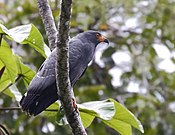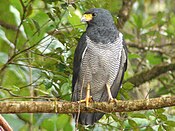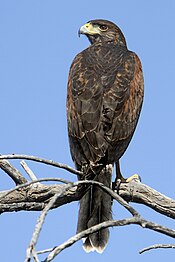Buteonine
Buteoninae
Subfamily of birds
The Buteoninae are a subfamily of birds of prey which consists of medium to large, broad-winged species.
| Buteoninae | |
|---|---|
| Western red-tailed hawk (Buteo jamaicensis calurus) | |
| Scientific classification | |
| Domain: | Eukaryota |
| Kingdom: | Animalia |
| Phylum: | Chordata |
| Class: | Aves |
| Order: | Accipitriformes |
| Family: | Accipitridae |
| Subfamily: | Buteoninae Vigors, 1825 |
| Genera | |
|
About 19, see article | |
They have large, powerful, hooked beaks for tearing flesh from their prey, strong legs, and powerful talons. They also have extremely keen eyesight to enable them to spot potential prey from a distance.
This subfamily contains the buzzards (buteonine hawks) with great diversity in appearance and form and some appearing eagle-like, with at least 50 species included overall in the subfamily. At one time, several types were grouped, including large assemblages such as booted eagles, but modern studies using mitochondrial DNA clarified that this subfamily was smaller than formerly classified.[1][2][3]
The subfamily Buteoninae was introduced (as "Buteonina") by the Irish zoologist Nicholas Vigors in 1825 with Buteo as the type genus.[4][5] The subfamily includes about 79 currently recognized species.[6] Unlike many lineages of Accipitridae, which seemed to have radiated out of Africa or South Asia, the Buteoninae clearly originated in the Americas based on fossil records and current species distributions (more than 75% of the extant raptors from this lineage are found in the Americas).[7][8]
A genus level cladogram of the Buteoninae is shown below. It is based on a molecular phylogenetic study of the family Accipitridae by Therese Catanach and collaborators that was published in 2024.[9]
| Buteoninae |
| ||||||||||||||||||||||||||||||||||||||||||||||||||||||||||||||||||||||||||||||||||||||||||||||||
Genera
| Tribe | Image | Genus | Species |
|---|---|---|---|
| Milvini Vigors 1824-milvine kites and sea and fish eagles. |  |
Milvus Lacépède, 1799 |
|
 |
Haliastur Selby, 1840 |
| |
 |
Haliaeetus Savigny, 1809 |
| |
 |
Icthyophaga Lesson, 1843 |
| |
| Buteonini Vigors 1824 |  |
Butastur Hodgson, 1843 |
|
 |
Ictinia Vieillot, 1816 |
| |
 |
Geranospiza Kaup, 1847 |
| |
 |
Busarellus Lesson, 1843 |
| |
 |
Rostrhamus Lesson, 1830 |
| |
 |
Helicolestes Bangs & Penard, 1918 |
| |
 |
Morphnarchus Ridgway, 1920 |
| |
 |
Cryptoleucopteryx Amaral et al., 2009 |
| |
 |
Buteogallus Lesson, 1830 |
| |
 |
Rupornis Kaup, 1844 |
| |
 |
Parabuteo Ridgway, 1874 |
| |
 |
Geranoaetus Kaup, 1844 |
| |
 |
Pseudastur Blyth, 1849 |
| |
 |
Leucopternis Kaup, 1847 |
| |
 |
Buteo Lacépède, 1799 |
| |
Extinct Genera
- †Bermuteo Olson, 2008
- †Garganoaetus Ballmann, 1973
- Lerner, H. R., Klaver, M. C., & Mindell, D. P. (2008). Molecular phylogenetics of the Buteonine birds of prey (Accipitridae). The Auk, 125(2), 304-315.
- Lerner, H. R., & Mindell, D. P. (2005). Phylogeny of eagles, Old World vultures, and other Accipitridae based on nuclear and mitochondrial DNA. Molecular Phylogenetics and Evolution, 37(2), 327-346.
- Lerner, H., Christidis, L., Gamauf, A., Griffiths, C., Haring, E., Huddleston, C. J., Kabra, S., Kocum, A., Krosby, M., Kvaloy, K., Mindell, D., Rasmussen, P., Rov, N., Wadleigh, R., Michael Wink & Gjershaug, J. O. (2017). Phylogeny and new taxonomy of the Booted Eagles (Accipitriformes: Aquilinae). Zootaxa 4216 (4), 301-320.
- Vigors, Nicholas Aylward (1825). "Sketches in ornithology ; or, observations on the leading affinities of some of the more extensive groups of birds". Zoological Journal. 2: 368-405 [393].
- Bock, Walter J. (1994). History and Nomenclature of Avian Family-Group Names. Bulletin of the American Museum of Natural History. Vol. 222. New York: American Museum of Natural History. pp. 172, 264.
- Gill, Frank; Donsker, David; Rasmussen, Pamela, eds. (December 2023). "Hoatzin, New World vultures, Secretarybird, raptors". IOC World Bird List Version 14.1. International Ornithologists' Union. Retrieved 3 April 2024.
- Brodkorb, P. (1964). Catalogue of fossil birds: Part 2 (Anseriformes through Galliformes). University of Florida.
- Lerner, H. R.; Klaver, M. C. & Mindell, D. P. (2008). "Molecular phylogenetics of the Buteonine birds of prey (Accipitridae)" (PDF). The Auk. 125 (2): 304–315. doi:10.1525/auk.2008.06161. Archived from the original (PDF) on 2021-08-31. Retrieved 2019-02-28.
- Catanach, T.A.; Halley, M.R.; Pirro, S. (2024). "Enigmas no longer: using ultraconserved elements to place several unusual hawk taxa and address the non-monophyly of the genus Accipiter (Accipitriformes: Accipitridae)". Biological Journal of the Linnean Society: blae028. doi:10.1093/biolinnean/blae028.
- Accipitridae videos on the Internet Bird Collection